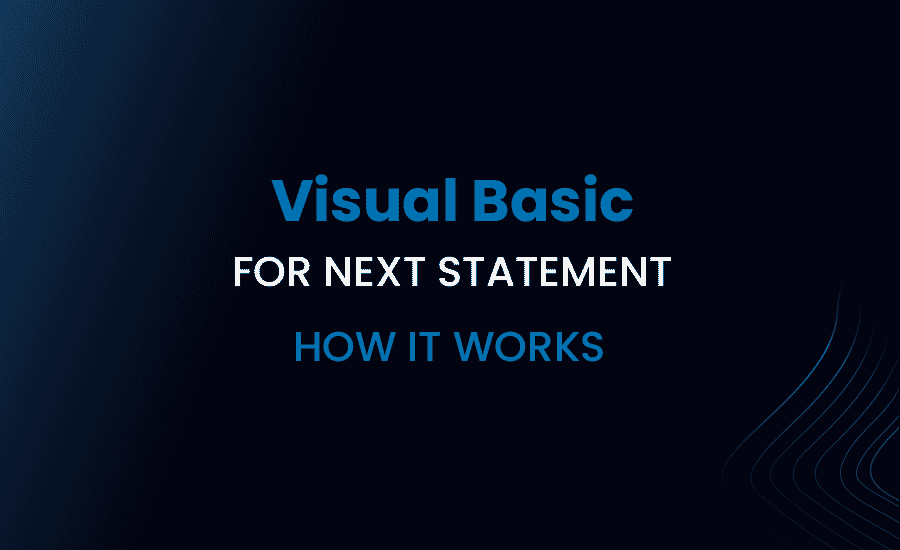Visual Basic For…Next Statement – How It Works

Programming languages can sometimes seem like a maze with different twists and turns, but here’s the good news. It doesn’t have to be! Let’s dive into one element that creates structure and simplifies code: the VB.Net For...Next loop. It can be your shining beacon in the complex dark underworld of coding. Excited? You bet!
Understanding VB Net For Loop
Imagine having a list of tasks to perform, but instead of doing them manually one after the other, you have a robotic assistant that completes them sequentially for you. That’s essentially what the For loop does in VB.Net.
A For loop is a control structure that allows a set of statements(such as processing data or interacting with users) to be executed a specified number of times. Now let’s get to know our handy robotic assistant better!
How to Write For Loop in VB Net
You wouldn’t write a letter without knowing the language, right? Same here – before we jump into code, let’s understand the primary components of a For loop.
Key Components of a For Loop
Let’s break down a for loop in VB.Net like a simple recipe.
Loading code snippet...
- Here
counteris a variable that controls the number of iterations. StartNumsignifies the starting point.EndNumspecifies the endpoint.Statementsis where we perform our tasks or actions.Nextis where we’re telling our robotic assistant, “Job’s done. Let’s move on to the next task.”
How to Use Date in For Loop in VB.Net
Ever felt the need to time-travel? Well, with the VB.Net For loop, you can! You can iterate or “loop” through specific dates. This can be handy for situations like calculating past dues, projecting future costs, and the like. Let’s look at an example:
Loading code snippet...
Here, we’re stepping through each day of the year 2020, essentially time-traveling across that year.
VB Net For Loop Examples
A spoonful of theory is always better with a taste of practical applications. Let’s delve into some tasty examples of the VB.Net For loop.
Basic For Loop Example
Loading code snippet...
In this example, the program displays “Loop iteration: x” five times, where x represents a number from one to five. Simple, right?
For Each Loop in VB Net Example
Let’s say you have a list of data, and you wonder how to deal with each item in that list. Here’s how For Each loop comes in handy!
Loading code snippet...
The For Each loop steps through each color in the ‘someColors’ array and prints it to the console.
How to Increment Value in For Loop in VB Net
In the For loop, you can control your increments. Instead of one step at a time, maybe you want to take two steps, three steps, or even ten steps at a time.
Loading code snippet...
Here, Step 2 increments the counter by 2 in each iteration, so you’re jumping 2 steps at a time.
How to Control For Loop Execution
What if you’re looping through some data, and you want to stop the loop prematurely? Thankfully, VB.Net allows you to control loop execution with several control statements.
How to Break For Loop in VB Net
Suppose you are searching for a particular value in an array. Now, there’s no point continuing the search once you’ve found the value, right? Here’s where the Exit For statement shines.
Loading code snippet...
If the loop encounters the number it’s looking for, it breaks the loop with Exit For and displays “Found the number!”.
How to Get Out of For Loop VB.Net
Loading code snippet...
In the above block of code, the loop exits when the counter reaches 5. So, it displays numbers from 1 to 4 only. Cool! Isn’t it?
Do While Loop For Dataset in VB.Net
There’s another type of loop – the Do while loop. It’s like saying, “Continue doing something WHILE a certain condition is true”.
Loading code snippet...
Here, we’re processing data in each row of a dataset until we reach the last row.
How Can Write For Loop in VB.Net
Well, congratulations on making it to the end! We’ve travelled through control structures, time travelled with date handling, navigated through various loop examples, and learned how to control their execution. Now go forth and conquer your code with VB.Net’s For loop! Who knows, your robotic assistant might even give you a virtual high five! Happy coding!
Remember, just like our brain is the supercomputer running our lives, loops are integral control structures driving our code towards its purpose. And just as we make choices every day, we choose the right loop structures based on our specific programming goals.





